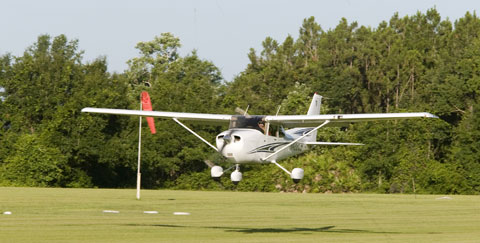
Don’t let reports of economic recovery fool you: The year ahead will be difficult for state governments.
In spite of modest revenue increases, the states will have to close budget gaps totaling $82.1 billion in 2011, according to the National Conference of State Legislatures. Now years into the recession, many have exhausted one-time revenue sources and have already made several rounds of cuts to make ends meet. This year, cuts may be deep.
“They cut all of the easy stuff first,” said Henry Ogrodzinski, president and CEO of the National Association of State Aviation Officials (NASAO). Then states made more far-reaching cuts, he said, such as furloughing staff and banning out-of-state travel. Now, in the third year of the recession, “just about every easy and a lot of the difficult things have already been done, and the states are still facing deficits,” he said.
Even deep cuts may not bridge the budget gaps in many states, which means lawmakers will look for revenue in new places—including new or increased taxes, said AOPA Vice President of Airports and State Advocacy Greg Pecoraro. In a difficult political climate for broad-based tax hikes, smaller demographic groups such as aircraft owners might find themselves targeted.

But the news may not be all bad for general aviation. Aviation groups have already begun reaching out to state lawmakers to urge them to protect the investments they’ve made in their states’ aviation infrastructure. Likewise, AOPA continues to explain the potential negative economic impact of singling out aircraft owners for increased taxes. The association has already reviewed more than 450 bills in states across the country that could affect general aviation and expects to review about 1,800 by year-end.
“State lawmakers face difficult decisions going into 2011, and many are already looking to aviation for cost cutting and revenue,” Pecoraro said. “We’re working hard to ensure that states keep their commitment to aviation infrastructure and that general aviation pilots and aircraft owners aren’t unfairly singled out for taxes.”
Deep cuts
The recession may have officially ended in 2009, but the upturn has yet to be felt for many Americans. And even as the nation as a whole sees signs of a long, slow climb, states typically lag behind the federal economy by six months to a year or more, Ogrodzinski said. High unemployment and home foreclosures have cut states’ tax base, he said, and the recession “took place immediately after a spate of tax cutting in states across the country.” Those income sources will come back—“but it’s going to take quite a lot of time.”

In the meantime, states must find a way to balance their Fiscal Year 2012 budget, which starts in July. Many have already tapped rainy day funds and cut back on spending—out-of-state travel bans are so widespread that NASAO had to cancel its spring convention, Ogrodzinski said. Lawmakers are starting to cut into the “heart and bones and soul” of programs, he said.
Ogrodzinski is particularly concerned for the budgets of state aviation agencies. Those agencies help small airports by offering their expertise in planning and help keep the nationwide system of public airports safe by offering educational programs, conducting obstruction studies and other research, and contributing to airport upkeep. Some employees at these agencies, including state aviation directors, have already experienced furloughs; and as legislators scour the budget for items to cut, the state portion of airport improvement projects could be at risk.
Airports considered significant to national air transportation receive grants for improvement projects through the federal Airport Improvement Program (AIP), which requires a portion of the cost to be paid by the state or local sponsor. The state and local match for AIP grants, which currently stands at 5 percentsignals to the FAA that an airport sponsor is committed to maintaining and improving its airport.
The good news, Ogrodzinski said, is that Congress is working toward a FAA reauthorization that would ensure long-term federal funding for these infrastructure projects across the country. But states could struggle to find the money for matching grants, pushing a larger portion of the responsibility onto municipalities, many of which are already on the ropes financially, he said. In addition, money from the American Recovery and Reinvestment Act of 2009, which funded airport projects with no matching investment, has been exhausted.

Aviation groups have their work cut out for them convincing lawmakers to protect the investments they’ve made in airport infrastructure. Part of that is an education effort, explaining to people who don’t necessarily fly GA how they benefit from small airports and the National Airspace System. AOPA’s GA Serves America campaign explains to lawmakers and the public how GA provides access to rural communities, enables firefighting and emergency services, supports agriculture and business, and more. Organizations like NASAO work alongside AOPA to reinforce that message with lawmakers.
“I tell them that we have the biggest and best aviation system in the world and we need to continue to maintain it at the same standard,” Ogrodzinski said.
A tax by any other name…
 Several governors and state legislators have pledged not to introduce or raise taxes this year, but that may offer little protection for aircraft owners.
Several governors and state legislators have pledged not to introduce or raise taxes this year, but that may offer little protection for aircraft owners.
AOPA is already seeing attempts to impose “specialty taxes,” which target a small group of people, in lieu of blanket tax hikes, said Pecoraro. Some of those are being presented as “fees,” but a tax is a tax, he added.
“Legislators are under a lot of pressure to find new revenue sources,” he explained. “Many of them see aircraft taxes as ‘low hanging fruit’—they perceive aircraft owners as affluent people who can afford an extra tax, and as a group too small to raise much objection. We’re working to dispel those myths and to ensure that aircraft owners are treated equitably.”
Specialty taxes for aviation aren’t new. AOPA has been fighting them for years, explaining how raising taxes on aircraft owners depresses aviation activity and in some cases drives businesses to neighboring states. Offering competitive tax rates and removing unnecessary use taxes can draw new business into the state, including nonaviation businesses that rely on GA for transportation, the association explains.
These efforts have had great success: In the dismal economic climate of 2010, a number of states proposed these taxes but the year closed with no new state taxes on GA. In fact, a years-long campaign to remove the Florida use tax on visiting out-of-state aircraft culminated in 2010 when the governor signed a permanent exemption into law. AOPA continues to work in Maine this year to promote a similar repeal that would welcome more visiting aircraft into the state.
But as states dig deeper in 2011 to fund infrastructure projects and keep government agencies afloat, the pain will likely be felt across the board. AOPA will look for opportunities to prevent tax increases, Pecoraro explained, but in some respects it’s a balancing act: States need to continue to fund vital airport improvement projects, and that revenue has to come from somewhere.
“We’re working to make sure that general aviation pilots and aircraft owners aren’t singled out for taxes and fees, and that states protect their investment in their aviation infrastructure,” he said. “States should not dip into aviation funds for nonaviation purposes, and they shouldn’t target aircraft owners with extra taxes. General aviation isn’t looking for special treatment, just a fair shake.”



